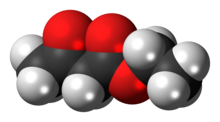
| |

| |
| Names | |
|---|---|
| Preferred IUPAC name
Ethyl 3-oxobutanoate | |
Other names
| |
| Identifiers | |
3D model (JSmol)
|
|
| ChEBI | |
| ChEMBL | |
| ChemSpider | |
| ECHA InfoCard | 100.005.015 |
| EC Number |
|
| KEGG | |
PubChem CID
|
|
| RTECS number |
|
| UNII | |
| UN number | 1993 |
CompTox Dashboard (EPA)
|
|
| |
| |
| Properties | |
| C6H10O3 | |
| Molar mass | 130.14 g/mol |
| Appearance | Colourless liquid |
| Odor | Fruit or rum |
| Density | 1.021 g/cm3, liquid |
| Melting point | −45 °C (−49 °F; 228 K) |
| Boiling point | 180.8 °C (357.4 °F; 453.9 K) |
| 2.86 g/100 ml (20 °C) | |
| Acidity (pKa) |
|
| −71.67×10−6cm3/mol | |
| Hazards | |
| GHS labelling:[1] | |

| |
| Warning | |
| H319 | |
| P305+P351+P338 | |
| NFPA 704 (fire diamond) | |
| Flash point | 70 °C (158 °F; 343 K) |
| Related compounds | |
Related esters
|
|
Related compounds
|
|
Except where otherwise noted, data are given for materials in their standard state (at 25 °C [77 °F], 100 kPa).
| |
The organic compound ethyl acetoacetate (EAA) is the ethyl ester of acetoacetic acid. It is a colorless liquid. It is widely used as a chemical intermediate in the production of a wide variety of compounds. It is used as a flavoring for food.[not verified in body]
YouTube Encyclopedic
-
1/5Views:24 85659 1812 51875 1655 528
-
Ethyl Acetate : Organic Synthesis
-
Acetoacetic Ester Synthesis Reaction Mechanism
-
Synthesis of ethyl acetoacetate - Síntesis del acetoacetato de etilo
-
Synthesis of Ethyl Acetate
-
Ethyl Acetate extraction
Transcription
Preparation
At large scale, ethyl acetoacetate is industrially produced by treatment of diketene with ethanol.[2]
The small scale preparation of ethyl acetoacetate is a classic laboratory procedure.[3] It involves Claisen condensation of ethyl acetate. Two moles of ethyl acetate condense to form one mole each of ethyl acetoacetate and ethanol.
Reactivity
Acidity
Ethyl acetoacetate is diprotic:[4]
- CH3C(O)CH2CO2Et + NaH → CH3C(O)CH(Na)CO2Et + H2
- CH3C(O)CH(Na)CO2Et + BuLi → LiCH2C(O)CH(Na)CO2Et + BuH
Keto-enol tautomerism
Ethyl acetoacetate is subject to keto-enol tautomerism. In the neat liquid at 33 °C, the enol consists of 15% of the total.[5]
Multicarbon building block
Ethyl acetoacetic acid is a building block in organic synthesis since the protons alpha to carbonyl groups are acidic, and the resulting carbanion undergoes nucleophilic substitution. Ethyl acetoacetate is often used in the acetoacetic ester synthesis similar to diethyl malonate in the malonic ester synthesis or the Knoevenagel condensation. A subsequent thermal decarboxylation is also possible.[6]
The dianion of ethylacetoacetate is also a useful building block, except that the electrophile adds to the terminal carbon. The strategy can be depicted in the following simplified form:[4]
- LiCH2C(O)CH(Na)CO2Et + RX → RCH2C(O)CH(Na)CO2Et + LiX
Ligand
Similar to the behavior of acetylacetone, the enolate of ethyl acetoacetate can also serve as a bidentate ligand. For example, it forms purple coordination complexes with iron(III) salts:
Reduction
Reduction of ethyl acetoacetate gives ethyl 3-hydroxybutyrate.
Transesterification
Ethyl acetoacetate transesterifies to give benzyl acetoacetate via a mechanism involving acetylketene. Ethyl (and other) acetoacetates nitrosate readily with equimolar sodium nitrite in acetic acid, to afford the corresponding oximinoacetoacetate esters. A dissolving-zinc reduction of these in acetic acid in the presence of ketoesters or beta-diketones constitute the Knorr pyrrole synthesis, useful for the preparation of porphyrins.
See also
- Fructone, the ethylene glycol ketal of ethyl acetoacetate, an aroma compound
References
- ^ Record in the GESTIS Substance Database of the Institute for Occupational Safety and Health, accessed on 2021-12-19.
- ^ Riemenschneider, Wilhelm; Bolt, Hermann M. (2005). Esters, Organic. doi:10.1002/14356007.a09_565.pub2. ISBN 3527306730.
- ^ J. K. H. Inglis and K. C. Roberts (1926). "Ethyl Acetoacetate". Organic Syntheses. 6: 36. doi:10.15227/orgsyn.006.0036.
- ^ a b Jin, Yinghua; Roberts, Frank G.; Coates, Robert M. (2007). "Stereoselective Isoprenoid Chain Extension with Acetoacetate Dianion: [(E, E, E)-Geranylgeraniol from (E, E)-Farnesol". Organic Syntheses. 84: 43. doi:10.15227/orgsyn.084.0043.
- ^ Jane L. Burdett; Max T. Rogers (1964). "Keto-Enol Tautomerism in β-Dicarbonyls Studied by Nuclear Magnetic Resonance Spectroscopy. I. Proton Chemical Shifts and Equilibrium Constants of Pure Compounds". J. Am. Chem. Soc. 86: 2105–2109. doi:10.1021/ja01065a003.
- ^ Carey, Francis A. (2006). Organic Chemistry (Sixth ed.). New York, NY: McGraw-Hill. ISBN 0-07-111562-5.



